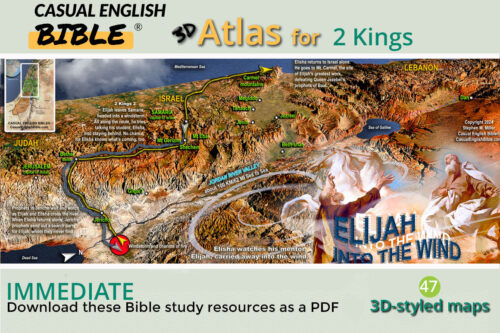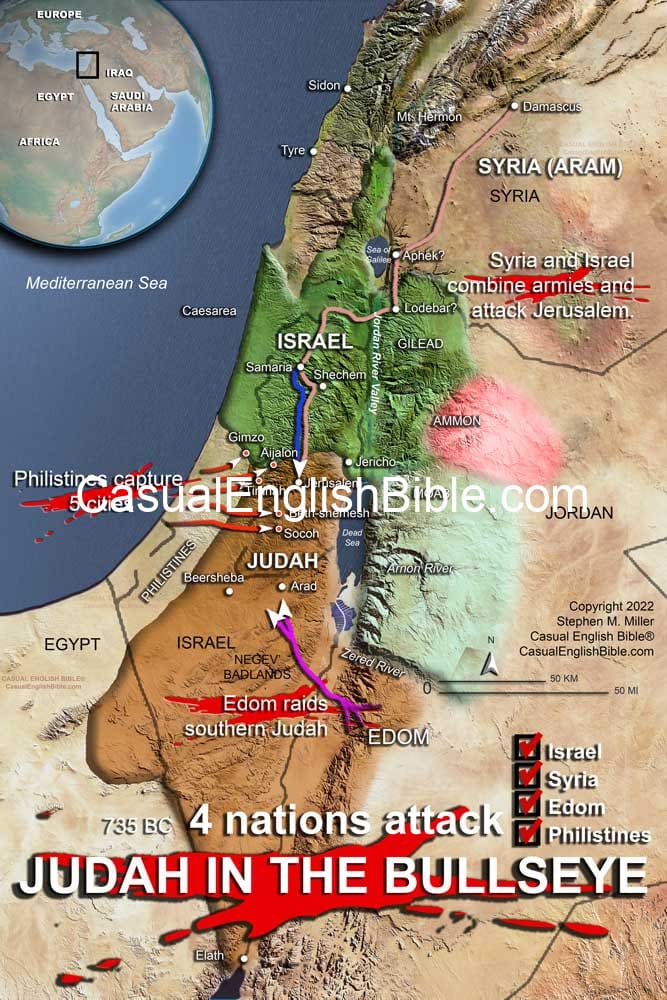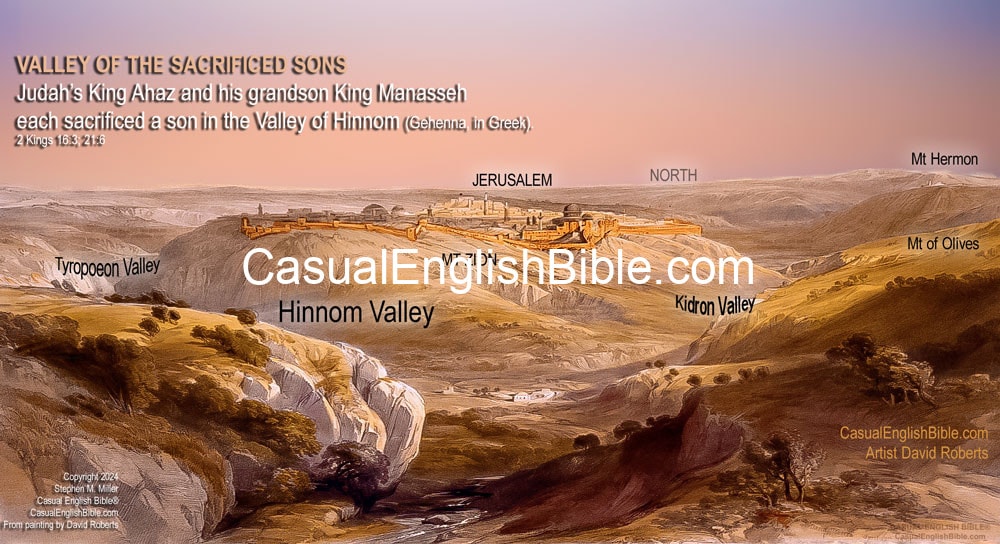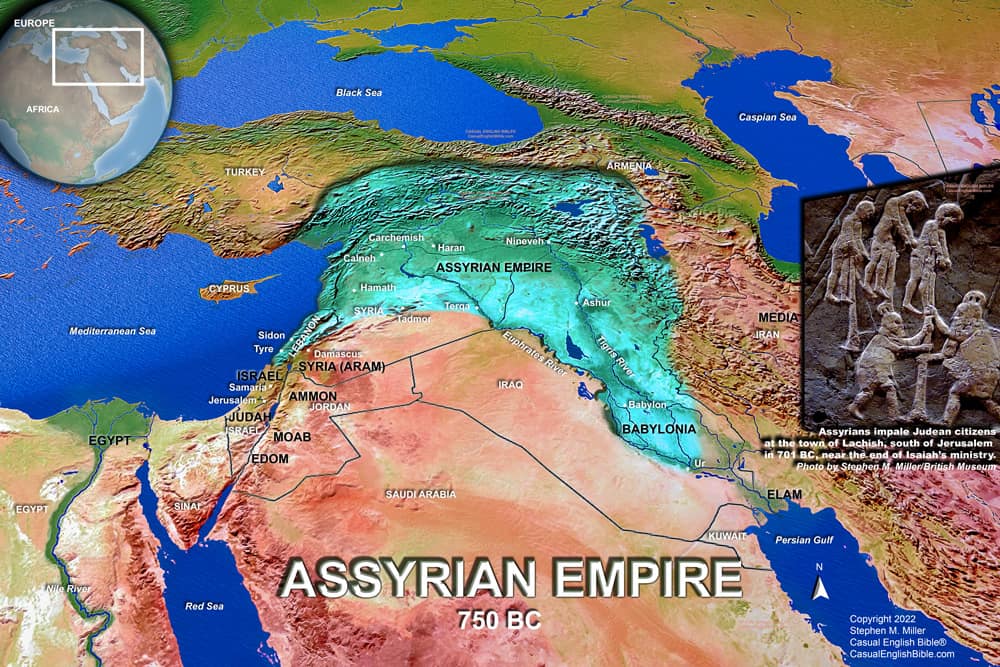2 Kings 16
Temple gets a Syrian altar
Ahaz, new king of Judah
2 Chronicles 28:1-27 1King Jotham’s son, Ahaz, became the next king of Judah. By then, King Pekah was into his 17th year of ruling Israel. Pekah was a son of Remaliah. 2Ahaz was 20 years old when he became king. He lived in Judah’s capital city of Jerusalem. He was not a good king in God’s eyes. He didn’t follow in the footsteps of his ancestor, David, who obeyed the LORD.
3Ahaz lived like the idol-worshiping kings of Israel. He even burned his son as a sacrifice, [1] which is despicable to God. Other nations used to do that, too, but God drove them off the land. 4Ahaz sacrificed at shrines set up on hilltops and under shade trees in the valleys.
5Syria’s King Rezin joined forces with Israel’s King Pekah to attack Jerusalem. But they couldn’t get past Ahaz’s defenses. 6During that campaign, Syria’s King Rezin overran Judah’s town of Elath and returned it to the nation of Edom. It once belonged to Edom, and now it does again. Jerusalem to Assyria: Rescue us
7Judah’s King Ahaz sent an urgent message to the Assyrian King Tiglath-pileser: “I am under attack by two armies. Syria’s king has united with Israel’s king in a campaign against Judah. I have served you as a son would. Please come and rescue me.” 8Ahaz collected all the silver and gold in the treasuries of the Temple and the palace and sent it to Assyria’s king.
9Assyria’s army captured Damascus, capital of Syria. They killed King Rezin and banished the captives to the territory of Kir. [2] Ahaz wants a Syrian altar
10When Ahaz went to Damascus to thank Assyria’s King Tiglath-pileser, he saw a sacrificial altar he liked. He had an exact model made of it and he sent the model back to Jerusalem, to a priest named Uriah. 11The priest used the model to replicate the full-sized altar in Damascus. It was finished by the time Ahaz got back from his trip.
12The king liked what he saw. So, he used it right away. 13He presented several offerings: burnt, grain, and wine. [3] He splashed [4] the blood of the sacrificed animal onto the sides of the altar. 14The king then decided to give the Temple worship area a makeover. He had the bronze altar moved to the north. He put his new altar in the center area. King’s part-time altar
15King Ahaz told the priest to use this altar for all the main sacrifices of each day. He said, “From now on, I want you to use this altar every morning for the burnt offering and every evening for the grain offering. Do the same for the king’s daily offerings. And do it for those offerings you make each day for the people of our nation. Sprinkle the blood on it, too. As for the old, bronze altar, I’ll use it to consult God.” 16Uriah followed the king’s orders.
17The king had the massive bronze bowl called the Sea lifted off its pedestal, the backs of a dozen bronze bulls. [5] He placed the Sea on a stone base. [6] 18He removed the Sabbath Room [7] built into the palace. He also removed the canopy leading from the palace to the Temple, a special entrance for the king. He made these changes to accommodate the king of Assyria. [8]
19The rest of Ahaz’s story is available in the History of Judah’s Kings. 20Ahaz died and was buried with his ancestors in the City of David. His son, Hezekiah, became the next king of Judah. Footnotes
116:3The phrase is literally “pass through fire.” This sounds like human sacrifice, which Jewish law forbids (Deuteronomy 18:10; Leviticus 18:21). But some Jews did it anyhow (2 Kings 23:10; Jeremiah 7:31). They did it in the Valley of Hinnom on the southwest side of Jerusalem; it was Gehenna in Greek, the international language in Jesus’ day. At some time, the people used that valley as a city dump, with a fire said to constantly smolder. The name of Gehenna became a metaphor describing God’s judgment. That’s because after the Jews started worshiping idols and sacrificing their own children in the valley, the Bible says God sent invaders from the Babylonian Empire, which came after the Assyrians. Babylonians temporarily wiped the Jewish nation off the political map, destroying Jerusalem and leveling the Temple.
216:9Location of Kir is uncertain. Isaiah 22:6 mentions it, too. Isaiah links it with Moab—and perhaps as a city inside Moab, one of Israel’s neighbors to the east. Some scholars say the original writer meant to say “city,” referring to Nineveh, capital of the Assyrian Empire. In Hebrew, “city” looks like this: עִיר. And the word translated as “Kir” qîr looks very similar: קִיר. Today, the ruins of Nineveh lie in northern Iraq, at Mosul.
316:13Burnt offerings were the most common animal sacrifice. Worshipers burned the entire animal to atone for their sins. Jews taught that in God’s eyes, sin was a capital offense. Jewish law, however, says God allowed them to substitute the death of an animal for the death they deserved. “Blood is what brings a body to life. I’ve given you blood to use exclusively on the altar. It atones for your sin—it gets rid of your guilt so you can stay on good terms with the LORD. Blood is the price of your sin” (Leviticus 17:11). The writer of Hebrews says the blood of Jesus was the last sacrifice needed; it paid the price for the sins of all people for all time (Hebrews 10:10). Grain and wine offerings were an expression of gratitude for a harvest and for the way God takes care of the Israelites. People offered the grain in several ways: ground to fine flour, presented as baked, fried, cooked, or roasted with olive oil.
416:13Splashing blood on the altar was a bit like splashing water on a person being baptized. It was a public ritual of consecration, essentially saying: “I’m devoted to God.”
516:17See 1 Kings 7:23-25.
616:17Scholars can only guess why the king made these changes. Perhaps he wanted to make it easier for worshipers and priests. Lowering the huge basin of water might have done that. The water was used to clean the area, washing away the blood. Or maybe the king wanted to make his new altar the main attraction of the worship area.
716:18The phrase in Hebrew is awkward and hard to interpret. It’s literally “the structure of the Sabbath built in the palace.”
816:18He made “these changes” because of the Assyrian king. “These changes” could refer to removing the bulls from the basin. Bulls were ancient symbols of strength. And the Assyrian king might not have liked seeing that in a subservient nation.
Discussion Questions
- Sorry, there are currently no questions for this chapter.
Videos
3Ahaz lived like the idol-worshiping kings of Israel. He even burned his son as a sacrifice, [1] which is despicable to God. Other nations used to do that, too, but God drove them off the land. 4Ahaz sacrificed at shrines set up on hilltops and under shade trees in the valleys.
5Syria’s King Rezin joined forces with Israel’s King Pekah to attack Jerusalem. But they couldn’t get past Ahaz’s defenses. 6During that campaign, Syria’s King Rezin overran Judah’s town of Elath and returned it to the nation of Edom. It once belonged to Edom, and now it does again.
Jerusalem to Assyria: Rescue us
7Judah’s King Ahaz sent an urgent message to the Assyrian King Tiglath-pileser: “I am under attack by two armies. Syria’s king has united with Israel’s king in a campaign against Judah. I have served you as a son would. Please come and rescue me.” 8Ahaz collected all the silver and gold in the treasuries of the Temple and the palace and sent it to Assyria’s king.9Assyria’s army captured Damascus, capital of Syria. They killed King Rezin and banished the captives to the territory of Kir. [2]
Ahaz wants a Syrian altar
10When Ahaz went to Damascus to thank Assyria’s King Tiglath-pileser, he saw a sacrificial altar he liked. He had an exact model made of it and he sent the model back to Jerusalem, to a priest named Uriah. 11The priest used the model to replicate the full-sized altar in Damascus. It was finished by the time Ahaz got back from his trip.12The king liked what he saw. So, he used it right away. 13He presented several offerings: burnt, grain, and wine. [3] He splashed [4] the blood of the sacrificed animal onto the sides of the altar. 14The king then decided to give the Temple worship area a makeover. He had the bronze altar moved to the north. He put his new altar in the center area.
King’s part-time altar
15King Ahaz told the priest to use this altar for all the main sacrifices of each day. He said, “From now on, I want you to use this altar every morning for the burnt offering and every evening for the grain offering. Do the same for the king’s daily offerings. And do it for those offerings you make each day for the people of our nation. Sprinkle the blood on it, too. As for the old, bronze altar, I’ll use it to consult God.” 16Uriah followed the king’s orders.17The king had the massive bronze bowl called the Sea lifted off its pedestal, the backs of a dozen bronze bulls. [5] He placed the Sea on a stone base. [6] 18He removed the Sabbath Room [7] built into the palace. He also removed the canopy leading from the palace to the Temple, a special entrance for the king. He made these changes to accommodate the king of Assyria. [8]
19The rest of Ahaz’s story is available in the History of Judah’s Kings. 20Ahaz died and was buried with his ancestors in the City of David. His son, Hezekiah, became the next king of Judah.
Footnotes
The phrase is literally “pass through fire.” This sounds like human sacrifice, which Jewish law forbids (Deuteronomy 18:10; Leviticus 18:21). But some Jews did it anyhow (2 Kings 23:10; Jeremiah 7:31). They did it in the Valley of Hinnom on the southwest side of Jerusalem; it was Gehenna in Greek, the international language in Jesus’ day. At some time, the people used that valley as a city dump, with a fire said to constantly smolder. The name of Gehenna became a metaphor describing God’s judgment. That’s because after the Jews started worshiping idols and sacrificing their own children in the valley, the Bible says God sent invaders from the Babylonian Empire, which came after the Assyrians. Babylonians temporarily wiped the Jewish nation off the political map, destroying Jerusalem and leveling the Temple.
Location of Kir is uncertain. Isaiah 22:6 mentions it, too. Isaiah links it with Moab—and perhaps as a city inside Moab, one of Israel’s neighbors to the east. Some scholars say the original writer meant to say “city,” referring to Nineveh, capital of the Assyrian Empire. In Hebrew, “city” looks like this: עִיר. And the word translated as “Kir” qîr looks very similar: קִיר. Today, the ruins of Nineveh lie in northern Iraq, at Mosul.
Burnt offerings were the most common animal sacrifice. Worshipers burned the entire animal to atone for their sins. Jews taught that in God’s eyes, sin was a capital offense. Jewish law, however, says God allowed them to substitute the death of an animal for the death they deserved. “Blood is what brings a body to life. I’ve given you blood to use exclusively on the altar. It atones for your sin—it gets rid of your guilt so you can stay on good terms with the LORD. Blood is the price of your sin” (Leviticus 17:11). The writer of Hebrews says the blood of Jesus was the last sacrifice needed; it paid the price for the sins of all people for all time (Hebrews 10:10). Grain and wine offerings were an expression of gratitude for a harvest and for the way God takes care of the Israelites. People offered the grain in several ways: ground to fine flour, presented as baked, fried, cooked, or roasted with olive oil.
Splashing blood on the altar was a bit like splashing water on a person being baptized. It was a public ritual of consecration, essentially saying: “I’m devoted to God.”
See 1 Kings 7:23-25.
Scholars can only guess why the king made these changes. Perhaps he wanted to make it easier for worshipers and priests. Lowering the huge basin of water might have done that. The water was used to clean the area, washing away the blood. Or maybe the king wanted to make his new altar the main attraction of the worship area.
The phrase in Hebrew is awkward and hard to interpret. It’s literally “the structure of the Sabbath built in the palace.”
He made “these changes” because of the Assyrian king. “These changes” could refer to removing the bulls from the basin. Bulls were ancient symbols of strength. And the Assyrian king might not have liked seeing that in a subservient nation.
Discussion Questions
- Sorry, there are currently no questions for this chapter.








